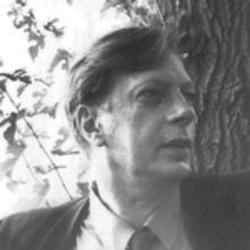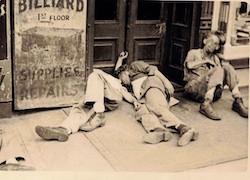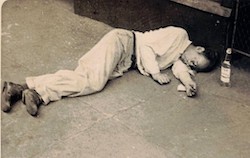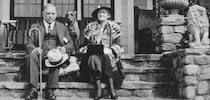|
|
|
 |
The Immortalist was a Nihilist
Posted on 19 June 2023, 7:38
The front and back covers of “The Immortalist,” a 1969 book, offer several rave endorsements of the book and its author, Alan Harrington (below). The New York Times refers to the book as “brilliant, biting – filled with trenchant insights and challenges to great truths.” The Christian Science Monitor calls it “an extraordinary book.” Gore Vidal states that Harrington “may have written the most important book of our time.” Dr. Alex Comfort refers to it as “a masterful job of relating man’s unrelenting quest for immortality to the problems plaguing the advanced technological societies of today.” Publisher’s Weekly wonders if Harrington is a visionary, prophet, madman, or pole-vaulter of the impossible.

Based on the title and the endorsements, one might infer that Harrington accepted the strong evidence often discussed at this blog that consciousness survives death in a greater reality. Not so. Other than briefly mentioning out-of-body experiences reported by Dr. Elisabeth Kűbler-Ross and the earliest research by Dr. Raymond Moody, Harrington gives no indication of being aware of the evidence and is clearly a nihilist suffering an acute case of death anxiety. What makes him different than other nihilists is that he admits his fear, to shaking in his boots at the thought of death, with no real attempts at displaying the usual facade of rationalized bravado, e.g., “So what, I’ll never know it.”
I quoted Harrington in my last blog, about the loneliness epidemic, but I’ll quote him again as a preface to further discussion: “A very few individuals, most having a remarkable capacity for self-deception, manage not to fear the end. The rest who claim that they are not afraid are either lying or keeping so busy that, blocked by bustling trivialities, thoughts of death rarely penetrate their reveries. But fear waits behind the door nevertheless. And the day they peer out and discover nothingness, the result can be catastrophic.”
Based on the endorsements, I assumed that Harrington was a well-known psychologist, psychiatrist, anthropologist, or philosopher of some kind, but I could find little about him other than that he graduated from Harvard in 1919, wrote a few novels, took LSD with Timothy Leary, read poetry with Allen Ginsberg, and taught at the University of Arizona He died in 1997, at age 79, of leukemia. How he qualifies as an authority on the subject matter I could not determine and I’m sure that some nihilists will strongly disagree with his comments about lying or repressing the idea of death, but Harrington has dug as deep or deeper than any other nihilists I have read and most of his views seem to represent the probable true mindset of the nihilist.
Harrington’s idea of immortality is to somehow live in the moment with no regard for the past or future, a condition he refers to as ‘reversion to the state of the baby animal” and “cosmic narcissism.” Education makes the anxiety worse, he claims. “Intellect has failed to deliver us from death,” he explains. “Worse, by stripping away illusions, the inductive pursuit of knowledge has made our forthcoming oblivion more disturbing than ever and the meaninglessness of existence more vividly clear.” He concludes that the myths of religion have been stripped away and that a terrible dark void is waiting for everyone. “The more advanced and aware of our unaccountably brief time on earth, the more vulnerable we become to feelings of isolating and midnight attacks of despair,” he offers. He quotes Gandhi in seeing life without an afterlife as “cruel mockery.” As for Dr. Kűbler-Ross’s statement that she knows “beyond the shadow of a doubt that there is life after death,” he counters that anyone familiar with LSD or having had nitrous oxide administered by a dentist can report the same “tripping out” experience, and therefore Kűbler-Ross’s studies are “no release from oblivion.” He doesn’t explain why he thinks out-of-body experiences supporting survival should be limited to traumatic events nor does he otherwise consider that they suggest mind-body duality no matter the trigger. There is no mention of the detailed consciousness research carried out by world-renowned scientists like Hare, Mapes, Wallace, Barrett, Crookes, Flammarion, Lodge, Geley, Stevenson, and others strongly supporting the survival hypothesis.
“As we grow more sophisticated, which is to say more ‘unnatural,’ ever more ingenious rationalizations are needed to explain death away,” he writes. “Faith survives among intelligent people, but not so easily now. The devout must somehow manage to embrace absurdity or ignore it. The second comes much more naturally.” It increases with age. “After the exuberance of being young, as young men and women grow only a little older, there begins to intrude on all our scenes a faint disquiet. At first it visits intermittently. The occasional feeling of a shadow seem not too important, perhaps an illusion. Then it reappears. In the beginning the shadow may be mistaken for doubt, about certain values such as justice; about the prosperity of brutes, a child with leukemia, death to the volunteer, safety for the malingerer. But then the uneasiness grows into something more important than doubt.”
Harrington goes on to say that when we are deprived of the rebirth vision, we suffer recurring spells of detachment, with either violence or apathy to follow. “And so the twin detachments of violence and apathy, side by side, are growing stronger and advancing within us.” He mentions riots in Detroit, Johannesburg, and other cities and says that “behind the proud and gleeful faces of the rioters, the raging countenances, the expressions of abandon, greed, and hatred, the contempt, and derisive laughter, can be detected the face of people desperate to be reborn.”
As with so many others, Harrington found television to be a great escape from boredom, the human condition, and thoughts of death. “It carries me instantly to other worlds and zones of being where death is not real,” he explains. “In my side-by-side worlds of my living room and the passing television scene (with TV Guide to help) we look out passively on eternal games. The family sits with gods and goddesses on late-night shows listening to them talk, watching them grow angry and argue and laugh together.”
He sees sports as possibly the best simulators of eternal life that humanity has available to it. “Sport is death-free play, and games shut out death,” he explains. “We have the commonly recognized but still quite amazing circumstance that for masses of people around the world, the outcome of football, baseball, soccer, basketball, and boxing matches can sometimes be far more important than actual wars and revolutions.” He claims that the madness of spectators and the dedication of the players can best be understood if such games are viewed as man-made immortality rites. “The stadium turns into a pit of the gods in which heroes fight to become divine. And trailing behind them come the legions – all of us, fans and spectators – who derive our being, our excellence, and our own worthiness to be converted into gods from the performance of our heroic representatives.”
Harrington’s book was published four years before the Pulitzer Prize-winning book, The Denial of Death, by anthropologist Ernest Becker, and I recall no reference to Becker’s earlier book in Harrington’s book; however, they both seem to be of the same mindset. It has been some years since I read Becker’s classic, but I’m fairly certain that he, too, completely ignores the psychical research carried out by the aforementioned scientists. Both Becker and Harrington seem to assume that science has killed off God and that the idea of consciousness surviving death went with it. My guess is that both authors had heard of the research, but knew little of it and heedlessly dismissed it as being in the same venue as the “superstitious” religious afterlife. Whatever references they had were no more than precursors of today’s Wikipedia and they were not about to waste time on such “ridiculous” research.
In searching for information on Harrington I came upon the Ernest Becker Foundation website and a 2009 article by Jason Silva discussing the “immortalism” of both Becker and Harrington. “The mindset of the Immortalist is pretty simple and straightforward,” Silva offers. “Death is an abhorrent imposition on a species able to reflect and care about meaning. Creatures that love and dream and create and yearn for something meaningful, eternal and transcendent should not have to suffer despair, decay, and death. We are the arbiters of value in an otherwise meaningless universe…”
Silva mentions that Becker identified three main devices for man to sustain his sanity in dealing with death anxiety: the Religious, the Creative and the Romantic. The God solution was focused on having faith in God, but, Silva says, “God never came.” The Creative solution had to do with leaving works of art behind for future generations to use and admire, while the Romantic solution called for turning our lovers into gods and goddesses. The evidence for a larger world, or spirit world, as developed by the early psychical researchers, as well as modern-day researchers, doesn’t fit into any of them. It is ignored, rejected, belittled. It is assumed that it was all bunk, but anyone who has really studied the research knows that it offers a sure cure for death anxiety. When will they ever see it?
Michael Tymn is the author of The Afterlife Revealed: What Happens After We Die, Resurrecting Leonora Piper: How Science Discovered the Afterlife, and Dead Men Talking: Afterlife Communication from World War I.
His latest book, No One Really Dies: 25 Reasons to Believe in an Afterlife is published by White Crow books.
Next blog post: July 3
Read comments or post one of your own
|
 |
Is the Loneliness Epidemic Rooted in Nihilism?
Posted on 05 June 2023, 8:13
“Loneliness now a public epidemic, top doctor says.” So reads the headline of an Associated Press article by Amanda Seitz appearing in the Honolulu Star-Advertiser on May 3, 2023. According to Dr. Vivek Murthy, the United States surgeon general, this widespread loneliness is said to be as deadly as smoking 15 cigarettes daily, while costing the health industry billions of dollars annually.

Murthy claims that about half the adults in the United States say they’ve experienced loneliness. However, there is no explanation as to how loneliness is defined or measured. I would have guessed that nearly everyone has experienced it to some degree, at one time or another, even if just homesickness or a spouse being away on a business trip. The point at which it becomes “deadly” is not given.

“Research shows that Americans, who have become less engaged with worship houses, community organizations, and even their own family members in recent decades, have steadily reported an increase in feelings of loneliness,” Seitz reports, adding that the crisis deeply worsened with COVID-19 and that it is hitting young people, ages 15-24, especially hard.
As I see it, it is all part of what psychiatrist Viktor Frankl referred to in his 1959 classic, Man’s Search for Meaning, as an “existential vacuum” – a widespread phenomenon of the twentieth century which, Frankl stated, manifests itself mainly in a state of boredom, which has its roots in emptiness and meaninglessness. “In actual fact, boredom is now causing, and certainly bringing to psychiatrists, more problems to solve than distress,” Frankl, who survived Nazi death camps, continues. “And these problems are growing increasingly crucial, for progressive automation will probably lead to an enormous increase in the leisure hours available to the average worker. The pity of it is that many of these will not know what to do with all their newly acquired free time.”
Those words were written more than 60 years before the COVID epidemic hit, but I’m old enough to look back and see the existential vacuum in its early stages with the dawn of television during the 1950s. Before television, people sat on their porches, talked with their neighbors, attended various social functions, met with friends and relatives in their homes, and otherwise mingled. Church activities were a significant part of that mingling. (That was before they were degraded by a cynical journalists to “worship houses,” perhaps the intent being to put them in the same category as whorehouses.)
While Murthy blames technology and social media for the loneliness, Frankl went much deeper, calling the existential vacuum a mass neurosis which might otherwise be described as a private and personal form of nihilism, a condition in which the person can find no meaning in life. Being a scientist and recognizing that science had more or less impeached religion by that time, and that most people can’t separate religious teachings from existential conclusions, Frankl was cautious in suggesting a “larger life,” one in which the lessons of suffering in this life open our eyes to the bigger picture, but he gave the larger life as an example of finding meaning in this life and concluded that the search for meaning in life, in itself, is the key to overcoming the neurosis.
Growing up during the 1940s, I knew the names of every neighbor on the block, which included about 20 homes. It was not unusual for my mother to be gardening in the front yard and talking with one of them. We had frequent visitors from family members and family picnics several times a year. All that changed with television as people shuttered themselves in their homes and children no longer went out to play with neighboring kids, preferring Howdy Doody and Captain Crunch. Gradually, over the next few decades, people got to unknow their neighbors, opting to stay behind shut doors while glued to their TV sets rather than chat face-to-face with neighbors or attend social functions. Sunday football replaced church services for many men. Madison Avenue and Hollywood continually educated the masses with the religion of materialism, which quickly extended to hedonism. The vacuum was clearly sucking in millions of people well before COVID, but the epidemic brought it all to a head.
In his 1969 book, The Immortalist, humanist philosopher Alan Harrington expressed it this way: “An unfortunate awareness has overtaken our species. Masses of men and women everywhere no longer believe that they have even the slightest chance of living beyond the grave. The unbeliever pronounces a death sentence on himself. For millions this can be not merely disconcerting but a disastrous perception.”
As Harrington, himself an atheist and nihilist, viewed it, when people are deprived of rebirth vision, they “suffer recurring spells of detachment, with either violence or apathy to follow.” Harrington saw mass-atheism as responsible for most, if not all, of society’s ills, including misplaced sexual energy. “Orgies, husband and wife swaps, and the like, more popular than ever among groups of quite ordinary people, represent a mass assault on the mortal barrier,” he opined.
“Atheism without hope has fathered this viciously creative effort – to try divine privilege on for size by reducing or destroying another for no particular reason,” Harrington continued. “The mild twin, apathy, grows from a deliberate reduction of consciousness which doesn’t care to deal with the unknown any more. One finds solace and safety in repetition, hours of torpor in front of a television set, and the like. The much-despised reflexes of conformity still prevalent in middle-class American life are part of this American withdrawal.”
With television, the pursuit of happiness was replaced with the pursuit of fun, which called for a loosening of moral values. Seemingly innocent television programs subtly promoted the new morality, one focused on sex. Fake wrestling represented the public’s indifference to separating reality from unreality, and it led to egomaniac clown acts in the boxing rings, and that quickly spread to other sports. Appreciative tips of the cap on the athletic field turned to shaking the fist, punching the sky, beckoning to the crowd for applause, idiotic end-zone dances, “take-that” slam dunks, and other haughty displays of individuality and hubris. The media couldn’t get enough of it, celebrating the most pompous athletes as the greatest. Television seemed to bottom out with the Jerry Springer Show during the 1990s – people screaming vulgarities and attacking each other as the audience laughed, unsure and uncaring as to how real the negative emotions were. If they were real, all the better the entertainment.
The loneliness problem is apparent to me whenever I see homeless people, which is daily, or visit someone at a retirement home, or whatever name is given to them. I had a somewhat rude awakening to the problem about 25 years ago when I visited an old friend at the Armed Forces Retirement Home in Washington, D.C. I expected to see many old veterans huddled around another one. laughing as they shared war stories or other experiences from an adventuresome past, but such was not the case. As with all other retirement homes where I have visited elderly relatives or friends, they sat around a TV set in the lobby, their heads drooping in wearisome silence or they remained in their rooms and watched television there. My friend, a very outgoing person, didn’t even know the name of the veteran occupying the room next to his. At lunch in the cafeteria, nearly all sat at separate tables, as if they didn’t know each other. To some extent, the isolation in retirement homes suggests that distance is not the primary cause of the loneliness problem.
“There’s really no substitute for in-person interaction,” Murthy is quoted. Given the reluctance of public officials to discuss religious matters while not fully grasping the difference between religious and existential issues, I doubt that Murthy has gone into the subject matter as deeply as Frankl and Harrington did. I suspect Murthy sees the decline of organized religion and the closing of churches as a factor, but I also doubt that he has really concerned himself with the existential aspects – the loss of meaning and the all-absorbing materialistic mentality that is accompanying the exodus from organized religion. Even if he has made the connection, it seems beyond government control.
Even though I am often critical of mainstream religion at this blog, I lament the fact that churches are losing members everywhere as the younger generation abandons them, those same younger people cited by Murthy suffering the most from loneliness, i.e., the 15-24 age group. Some belief, some faith has to be better than a nihilistic outlook.
As Harrington analyzed it, men and women of the past were able to hold on to their peace of mind by repetitive prayer, chants, rhythms and psalms set to music. “But repetition, beauty and music no longer possess the force to distract us from meaninglessness,” he concluded. I wonder how Harrington would have analyzed what is called music today.
He goes on to say that failure to move with the death-rebirth rhythm makes us feel out of sorts, despondent, and vicious. “A very few individuals, most having a remarkable capacity for self-deception, manage not to fear the end,” Harrington continued, no doubt including those of us who have accepted the evidence for an afterlife without input from organized religions as among the deceived. “The rest who claim that they are not afraid are either lying or keeping so busy that, blocked by bustling trivialities, thoughts of death rarely penetrate their reveries. But fear waits behind the door nevertheless. And the day they peer out and discover nothingness, the result can be catastrophic.”
The bottom line here is that the loneliness problem goes much deeper than government officials care to dig and that there does not appear to be an immediate fix for the problem. It’s going to take decades for the upward swing to take place, unless some catastrophic event provides a more hasty return to the search for meaning in life.
Michael Tymn is the author of The Afterlife Revealed: What Happens After We Die, Resurrecting Leonora Piper: How Science Discovered the Afterlife, and Dead Men Talking: Afterlife Communication from World War I.
His latest book, No One Really Dies: 25 Reasons to Believe in an Afterlife is published by White Crow books.
Next blog post: June 19
Read comments or post one of your own
|
|
|
 |
 |
 |
 |
 |
|
|
 |
 |
 |
 |
 |
| Mackenzie King, London Mediums, Richard Wagner, and Adolf Hitler by Anton Wagner, PhD. – Besides Etta Wriedt in Detroit and Helen Lambert, Eileen Garrett and the Carringtons in New York, London was the major nucleus for King’s “psychic friends.” In his letter to Lambert describing his 1936 European tour, he informed her that “When in London, I met many friends of yours: Miss Lind af Hageby, [the author and psychic researcher] Stanley De Brath, and many others. Read here |
|